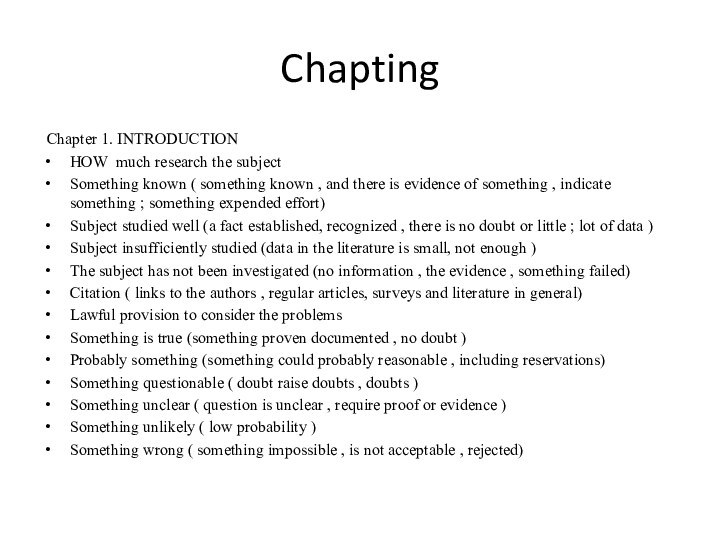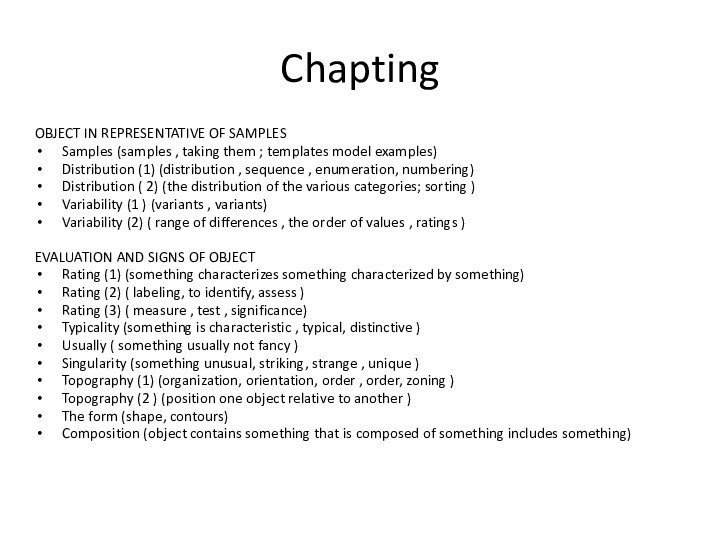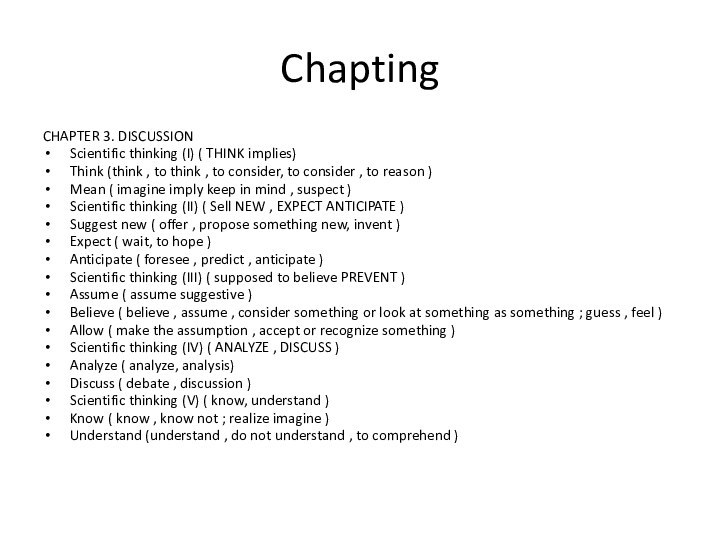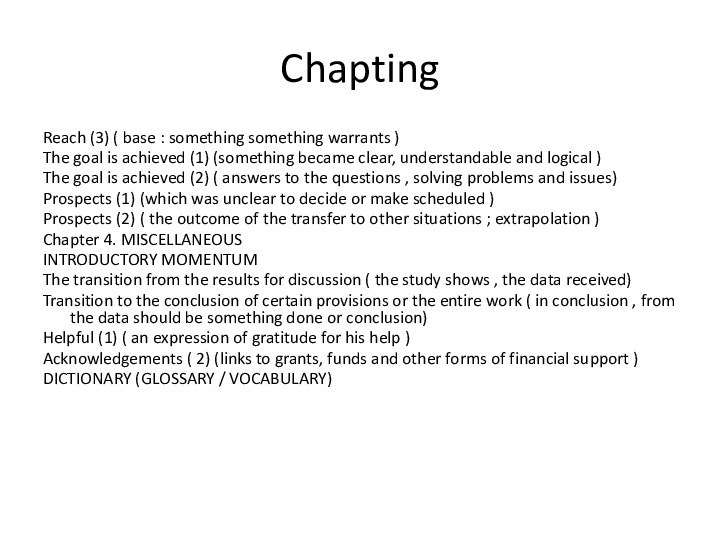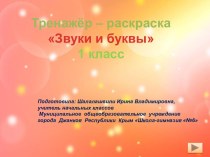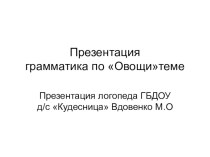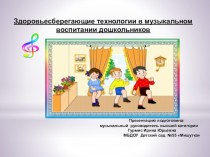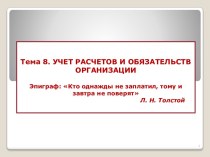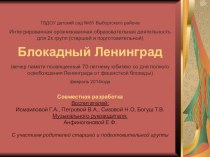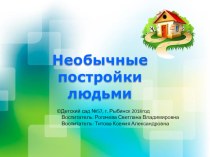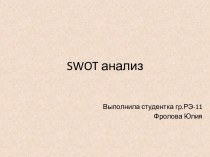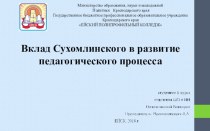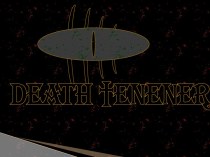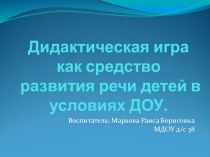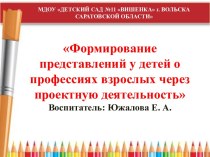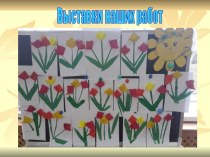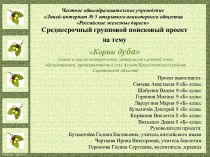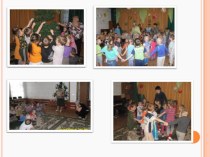Слайд 2
Chapting
RELEVANCE
New thing (something the first time studied ;
copyrights priorities)
Interesting thing (something interesting , curious)
Important thing (something
important , valuable, fundamentally , is of particular importance )
Incentives for research ( interest; existing problems, questions, problems , a real opportunity to solve them ) .
The subject of reserch
Statement of purpose (1) ( which is scheduled to do)
Statement of purpose (2) (why and what is planned to do)
Statement of purpose (3) ( what means , and why it is planned to make
The main outcome (short description of the results , the final section of "Introduction" )
Слайд 3
Chapting
Chapter 2. RESULTS
PRESENTATION OF RESEARCH FACILITY
The researcher observes
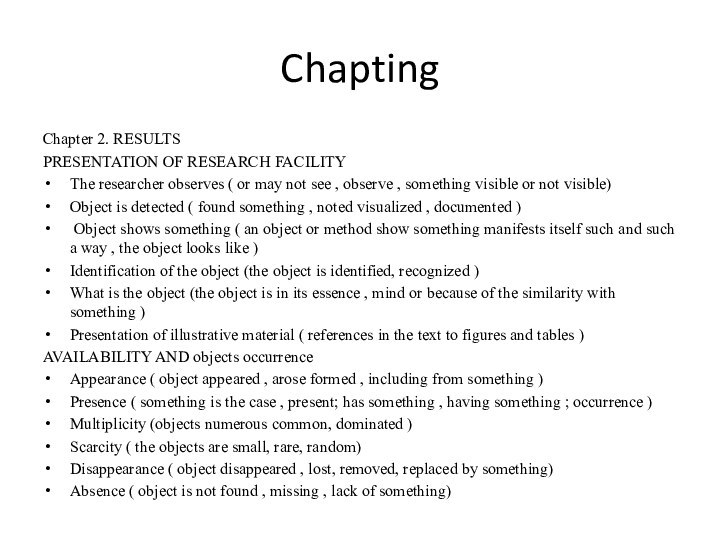
( or may not see , observe , something
visible or not visible)
Object is detected ( found something , noted visualized , documented )
Object shows something ( an object or method show something manifests itself such and such a way , the object looks like )
Identification of the object (the object is identified, recognized )
What is the object (the object is in its essence , mind or because of the similarity with something )
Presentation of illustrative material ( references in the text to figures and tables )
AVAILABILITY AND objects occurrence
Appearance ( object appeared , arose formed , including from something )
Presence ( something is the case , present; has something , having something ; occurrence )
Multiplicity (objects numerous common, dominated )
Scarcity ( the objects are small, rare, random)
Disappearance ( object disappeared , lost, removed, replaced by something)
Absence ( object is not found , missing , lack of something)
Слайд 4
Chapting
OBJECT IN REPRESENTATIVE OF SAMPLES
Samples (samples , taking
them ; templates model examples)
Distribution (1) (distribution , sequence
, enumeration, numbering)
Distribution ( 2) (the distribution of the various categories; sorting )
Variability (1 ) (variants , variants)
Variability (2) ( range of differences , the order of values , ratings )
EVALUATION AND SIGNS OF OBJECT
Rating (1) (something characterizes something characterized by something)
Rating (2) ( labeling, to identify, assess )
Rating (3) ( measure , test , significance)
Typicality (something is characteristic , typical, distinctive )
Usually ( something usually not fancy )
Singularity (something unusual, striking, strange , unique )
Topography (1) (organization, orientation, order , order, zoning )
Topography (2 ) (position one object relative to another )
The form (shape, contours)
Composition (object contains something that is composed of something includes something)
Слайд 5
Chapting
COMPARATIVE EVALUATION
Comparison ( compare, compare , comparison )
Identity
(the objects are identical, indistinguishable, have common features)
Similarity (objects
similar to each other , resemble something)
Differences (1) ( objects or events are different in quality)
Differences (2) (measured and quantitatively distinct differences )
Statistics (some parameters)
PROCESS
Initial state ( normal state , the control , return to normal )
Induction (something triggers induces activates something gives rise to something )
Stroke ( process : something happens proceeds being implemented, there is a )
Participation (something involved in something involved in something )
Correlation (something correlates with something , accompanied by something)
Regulation (something regulates , controls , programs , codes, something)
Termination (something stopped, stopped, ended, interrupted )
Dating ( time stamp events , duration , speed processes)
Слайд 6
Chapting
ACTION AGENT APPLICATION
Influence (something acts , affects something
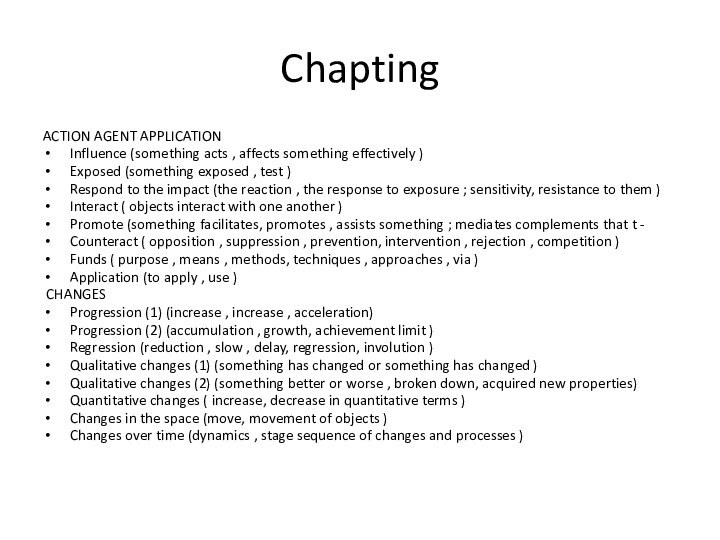
effectively )
Exposed (something exposed , test )
Respond to the
impact (the reaction , the response to exposure ; sensitivity, resistance to them )
Interact ( objects interact with one another )
Promote (something facilitates, promotes , assists something ; mediates complements that t -
Counteract ( opposition , suppression , prevention, intervention , rejection , competition )
Funds ( purpose , means , methods, techniques , approaches , via )
Application (to apply , use )
CHANGES
Progression (1) (increase , increase , acceleration)
Progression (2) (accumulation , growth, achievement limit )
Regression (reduction , slow , delay, regression, involution )
Qualitative changes (1) (something has changed or something has changed )
Qualitative changes (2) (something better or worse , broken down, acquired new properties)
Quantitative changes ( increase, decrease in quantitative terms )
Changes in the space (move, movement of objects )
Changes over time (dynamics , stage sequence of changes and processes )
Слайд 7
Chapting
CHAPTER 3. DISCUSSION
Scientific thinking (I) ( THINK implies)
Think
(think , to think , to consider, to consider
, to reason )
Mean ( imagine imply keep in mind , suspect )
Scientific thinking (II) ( Sell NEW , EXPECT ANTICIPATE )
Suggest new ( offer , propose something new, invent )
Expect ( wait, to hope )
Anticipate ( foresee , predict , anticipate )
Scientific thinking (III) ( supposed to believe PREVENT )
Assume ( assume suggestive )
Believe ( believe , assume , consider something or look at something as something ; guess , feel )
Allow ( make the assumption , accept or recognize something )
Scientific thinking (IV) ( ANALYZE , DISCUSS )
Analyze ( analyze, analysis)
Discuss ( debate , discussion )
Scientific thinking (V) ( know, understand )
Know ( know , know not ; realize imagine )
Understand (understand , do not understand , to comprehend )
Слайд 8
Chapting
FROM VIEWS TO THEORY
Opinion (1) ( opinion, judgment

, the idea of something )
Opinion (2) ( opinion,
point of view , position )
Idea (1) (idea, a new idea or suggestion )
Idea (2) ( claim to assert ; speculate ; imagination impression)
Concept ( concept, conceptual )
Hypothesis ( A hypothesis is a hypothesis)
Postulate ( postulate )
Theory (the theory, theoretical)
The reasoning : ANALYSIS
Evaluation on the grounds (1) (something indicates something is an indication of something)
Rating criteria ( 2) ( reflects something or reflected )
Certificate (1 ) ( evidence arguments )
Certificate (2) ( evidence , the arguments in favor )
Evidence (3) ( evidence against the absent , insufficient
or uncertain )
Match facts and some other estimates (1) (something confirmed support or complement something)
Match facts and some other estimates (2) (something consistent with something ; corresponds to something valid for something)
Match facts and some other estimates (3) (something contradicts something at odds with something ; spores)
Слайд 9
Chapting
Causal relationships (1) (something causes something, something causes
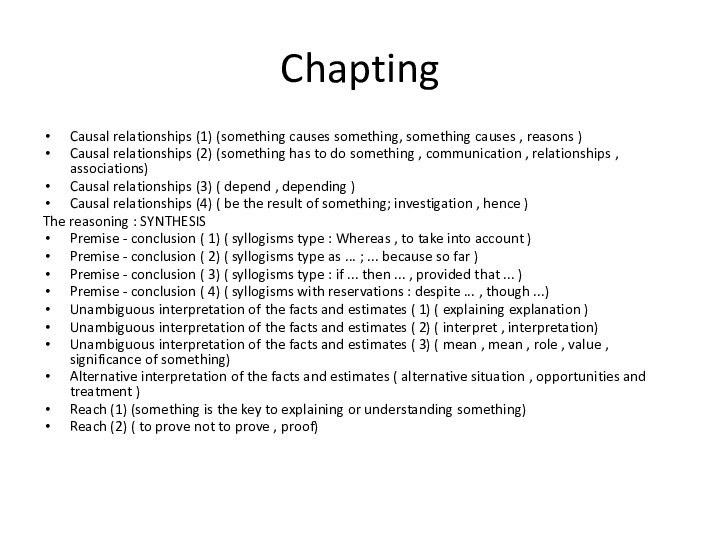
, reasons )
Causal relationships (2) (something has to do
something , communication , relationships , associations)
Causal relationships (3) ( depend , depending )
Causal relationships (4) ( be the result of something; investigation , hence )
The reasoning : SYNTHESIS
Premise - conclusion ( 1) ( syllogisms type : Whereas , to take into account )
Premise - conclusion ( 2) ( syllogisms type as ... ; ... because so far )
Premise - conclusion ( 3) ( syllogisms type : if ... then ... , provided that ... )
Premise - conclusion ( 4) ( syllogisms with reservations : despite ... , though ...)
Unambiguous interpretation of the facts and estimates ( 1) ( explaining explanation )
Unambiguous interpretation of the facts and estimates ( 2) ( interpret , interpretation)
Unambiguous interpretation of the facts and estimates ( 3) ( mean , mean , role , value , significance of something)
Alternative interpretation of the facts and estimates ( alternative situation , opportunities and treatment )
Reach (1) (something is the key to explaining or understanding something)
Reach (2) ( to prove not to prove , proof)
